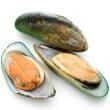Background
- The green-lipped mussel is native to the New Zealand coast and is a staple in the diet of the indigenous Maori culture. The anti-inflammatory effects of green-lipped mussel have been studied since the observation of a lower incidence of arthritis in coastal Maoris compared with European or inland Maori people.
- Products containing green-lipped mussel are used to treat inflammatory conditions such as asthma, osteoarthritis, and rheumatoid arthritis. Evidence of an effect in asthma and osteoarthritis is unclear, while evidence suggests green-lipped mussel is not effective in treating rheumatoid arthritis.
References
Natural Standard developed the above evidence-based information based on a thorough systematic review of the available scientific articles. For comprehensive information about alternative and complementary therapies on the professional level, go to . Selected references are listed below.
- Cho SH, Jung YB, Seong SC, et al. Clinical efficacy and safety of Lyprinol, a patented extract from New Zealand green-lipped mussel (Perna Canaliculus) in patients with osteoarthritis of the hip and knee: a multicenter 2-month clinical trial. Eur Ann Allergy Clin Immunol 2003;35(6):212-216.
View Abstract - Butters DE, Whitehouse MW. Treating inflammation: some (needless) difficulties for gaining acceptance of effective natural products and traditional medicines. Inflammopharmacology. 2003;11(1):97-110.
View Abstract - Ferreira SH. Proposal to use pentoxifylline and Lyprinol therapy for chronic inflammatory diseases. Inflammopharmacology. 2005;13(5-6):429-430.
View Abstract - Gruenwald J, Graubaum H, Hansen K, et al. Efficacy and tolerability of a combination of LYPRINOL and high concentrations of EPA and DHA in inflammatory rheumatoid disorders... eicosapentaenoic acid... decosahexaenoid acid. Advances in Therapy 2004;21(3):197-201.
- Halliday J. Not all green lipped mussel extracts are created equal. NutraIngredients.com Europe 2008.
- Ishida H, Nozawa A, Nukaya H, et al. Confirmation of brevetoxin metabolism in cockle, Austrovenus stutchburyi, and greenshell mussel, Perna canaliculus, associated with New Zealand neurotoxic shellfish poisoning, by controlled exposure to Karenia brevis culture. Toxicon 2004;43(6):701-712.
View Abstract - Lau S, Chiu PK, Chu EMY., et al. Treatment of knee osteoarthritis with Lyprinol, lipid extract of the green-lipped mussel - a double-blind placebo-controlled study. Progress in Nutrition 2004;61(17):17-31.
- Mani S, Lawson JW. In vitro modulation of inflammatory cytokine and IgG levels by extracts of Perna canaliculus. BMC Complement Altern Med 2006;6:1.
View Abstract - McPhee S, Hodges LD, Wright PF, et al. Anti-cyclooxygenase effects of lipid extracts from the New Zealand green-lipped mussel, Perna canaliculus. Comp Biochem Physiol B Biochem Mol.Biol 2007;146(3):346-356.
View Abstract - Miles CO, Wilkins AL, Munday R, et al. Isolation of pectenotoxin-2 from Dinophysis acuta and its conversion to pectenotoxin-2 seco acid, and preliminary assessment of their acute toxicities. Toxicon 2004;43(1):1-9.
View Abstract - Tenikoff D, Murphy KJ, Le M, et al. Lyprinol (stabilised lipid extract of New Zealand green-lipped mussel): a potential preventative treatment modality for inflammatory bowel disease. J Gastroenterol 2005;40(4):361-365.
View Abstract - Torres DM, Tooley KL, Butler RN, et al. Lyprinol only partially improves indicators of small intestinal integrity in a rat model of 5-fluorouracil-induced mucositis. Cancer Biol Ther 2008;7(2):295-302.
View Abstract - Yuan G, Wahlqvist ML, He G, et al. Natural products and anti-inflammatory activity. Asia Pac J Clin Nutr 2006;15(2):143-152.
View Abstract - Whitehouse MW. Prostanoids as friends, not foes: further evidence from the interference by cycloxygenase-inhibitory drugs when inducing tolerance to experimental arthritigens in rats. Inflammopharmacology. 2005;12(5-6):481-492.
View Abstract - Whitehouse MW. Anti-TNF-alpha therapy for chronic inflammation: reconsidering pentoxifylline as an alternative to therapeutic protein drugs. Inflammopharmacology. 2004;12(3):223-227.
View Abstract







